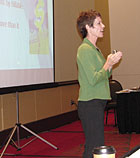
Ellen Rohr talked with oil heat contractors about solar heat selling techniques during a seminar she hosted with her husband at the NAOHSM annual meeting.
Ellen divided audience members into groups and they talked about the reasons they were attending the solar heat seminar. Some of the reasons included:
• High price of fuel oil is forcing customers to look for alternative fuel sources;
• Some contractors remove old solar equipment from homes and want to know why;
• What is the payback for installing solar?;
• How can it be linked to hydronics?;
• Contractors want general and updated information.
Hot Rod pointed out that enough sunlight falls on the Earth in one day to generate heat for the entire population for one year. “Solar is going to be big, stay big, and you should all be part of it now,” he said.
While solar’s popularity peaked and fizzled in the ’70s in the United States, it continued to be perfected in Europe, according to Hot Rod. “A lot of low-budget systems were installed in the U.S. so people could get rebates,” he said. “But some of them were used sparingly or never used at all and became obsolete.”
CONSULTING WITH THE CUSTOMER
Hot Rod said customers with a curiosity about solar heating for their homes should be given an in-home consultation rather than just information over the phone. “When a customer calls, ask if you could go out and give a site assessment,” he said. During the assessment, contractors can look for such things as where to locate solar panels (roof, walls, grounds), obstructions that would prevent sunlight from reaching panels, and routes needed to install piping and equipment.“Make sure that solar equipment meets local building codes, too,” he added.
Hot Rod noted any home or business owner can see if their building is a good candidate for solar heating by using the Website Google Earth, which shows how much sunlight hits a building.
“It is also important to compare the efficiency of solar collectors. Two examples would be a flat plate collector and a evacuated tube collector.” Once a determination has been made on how to gather and store the solar energy, Hot Rod said it is important to use solar-rated components and not hydronic-rated components. He believes the “best bang for the buck” is a domestic hot water pre-heat system tied to solar panels.
“Remember that solar is not designed to replace a heating system and that should be made clear to the home or business owner,” he said. “There are some days when solar will not be efficient because of the lack of sun or snow on the panels.”

Hot Rod Rohr talked about the nuances of solar heating to a overflow crowd during the seminar titled “Bringing Solar to Your Heating Mix.”
SELLING SOLAR
Ellen said just because solar is an interesting alternative fuel source, contractors “don’t need everyone as a solar customer.” It is still a niche market in most parts of the United States.“We are not comparing apples to oranges,” she said. “Don’t try to sell a competitive bid using apples-to-oranges thinking. You don’t want to commoditize solar.”
Ellen recommended that contractors differentiate themselves and come up with a specific tag line when selling solar systems. “Develop a system that you can use to sell solar - and then teach it to someone else, too,” she said.
If contractors can’t convince customers to purchase solar collectors, it is possible for customers to lease them, according to Hot Rod. “Commercial businesses lease solar panels, maybe it is possible to do the same in the residential sector,” he said. “In any event, you want to become your customer’s domestic hot-water supplier.”
Publication date:06/16/2008

Report Abusive Comment